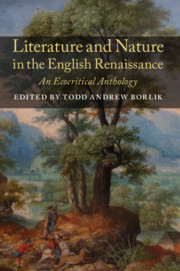Book contents
- Frontmatter
- Contents
- List of Illustrations
- Acknowledgements
- Editorial Principles: Towards the Ecocritical Editing of Renaissance Texts
- Introduction
- PART I Cosmologies
- PART II The Tangled Chain
- PART III Time and Place
- Seasons
- Country Houses
- Gardens
- Pastoral: Pastures, Meadows, Plains, Downs
- Georgic: Fields, Farms
- Forests, Woods, Parks
- Heaths, Moors
- Mountains, Hills, Vales
- Lakes, Rivers, Oceans
- PART IV Interactions
- PART V Environmental Problems in Early Modern England
- PART VI Disaster and Resilience in the Little Ice Age
- Appendix A Industrialization and Environmental Legislation in the Early Anthropocene: A Timeline
- Appendix B Further Reading: A Bibliography of Environmental Scholarship on the English Renaissance
Seasons
from PART III - Time and Place
Published online by Cambridge University Press: 05 June 2019
- Frontmatter
- Contents
- List of Illustrations
- Acknowledgements
- Editorial Principles: Towards the Ecocritical Editing of Renaissance Texts
- Introduction
- PART I Cosmologies
- PART II The Tangled Chain
- PART III Time and Place
- Seasons
- Country Houses
- Gardens
- Pastoral: Pastures, Meadows, Plains, Downs
- Georgic: Fields, Farms
- Forests, Woods, Parks
- Heaths, Moors
- Mountains, Hills, Vales
- Lakes, Rivers, Oceans
- PART IV Interactions
- PART V Environmental Problems in Early Modern England
- PART VI Disaster and Resilience in the Little Ice Age
- Appendix A Industrialization and Environmental Legislation in the Early Anthropocene: A Timeline
- Appendix B Further Reading: A Bibliography of Environmental Scholarship on the English Renaissance
Summary
When the Italian Renaissance arrived in England in the 1530s via the works of Sir Thomas Wyatt and Henry Howard, the Earl of Surrey, it encouraged a newfound appreciation of nature as a storehouse of imagery. Nevertheless, readers should not presume Howard's sonnet records a first-hand encounter with the environment; a translation of Petrarch's Rime 310, it presents, like much Renaissance pastoral, a mediated literary landscape. Moreover, as in Shakespeare's Sonnets 98 and 99 and Thomas Lodge's “The earth late choked with showers,” the closing couplet registers an intensification of inwardness that alienates the human subject from the rhythms of the seasons (it may even have been written while Howard was in prison). Significantly, however, Howard replaces several of Petrarch's classical allusions with English fauna, thus imbuing the poem with an earthier feel and adapting it to match the local environment. In this regard it is noteworthy that the title (following Petrarch) names the season as spring while the poem identifies it as summer. This confusion reflects the looser usage of the two terms in early modern England, when summer officially began not on the solstice (then called Midsummer) but on 1 May. Rather than hail spring or summer, English poets often praise May as the ideal compound of both, so it was in effect a season of its own, while the annual tradition (which came under assault after the Reformation) of gathering greenery and dancing round the maypole on May Day encouraged human communities to participate in the drama of biological renewal (see Dekker's “Merry Month of May” and Herrick's “Corinna's Going A-Maying”).
Source: Songs and Sonnets (1557), A2v.
The soot ° season that bud and bloom forth brings,
With green hath clad the hill and eke the vale.
The nightingale with feathers new she sings,
The turtle ° to her mate hath told her tale.
Summer is come, for every spray now springs.
The hart hath hung his old head ° on the pale,
The buck in brake his winter coat he flings,
The fishes fleet with new-repaired scale,
The adder all her slough ° away she slings,
The swift swallow pursueth the flies small,
The busy bee her honey now she mings.°
- Type
- Chapter
- Information
- Literature and Nature in the English RenaissanceAn Ecocritical Anthology, pp. 207 - 216Publisher: Cambridge University PressPrint publication year: 2019



